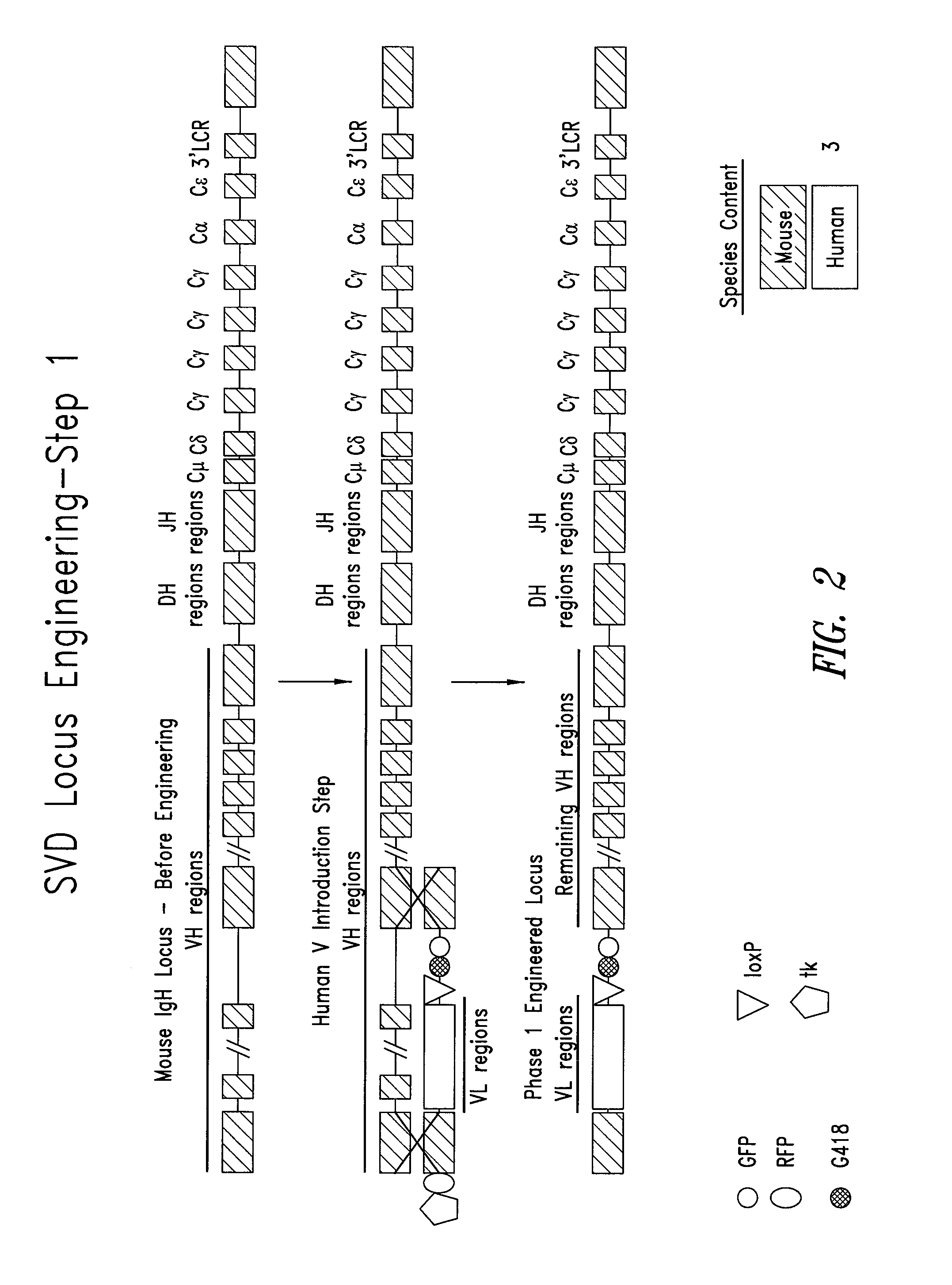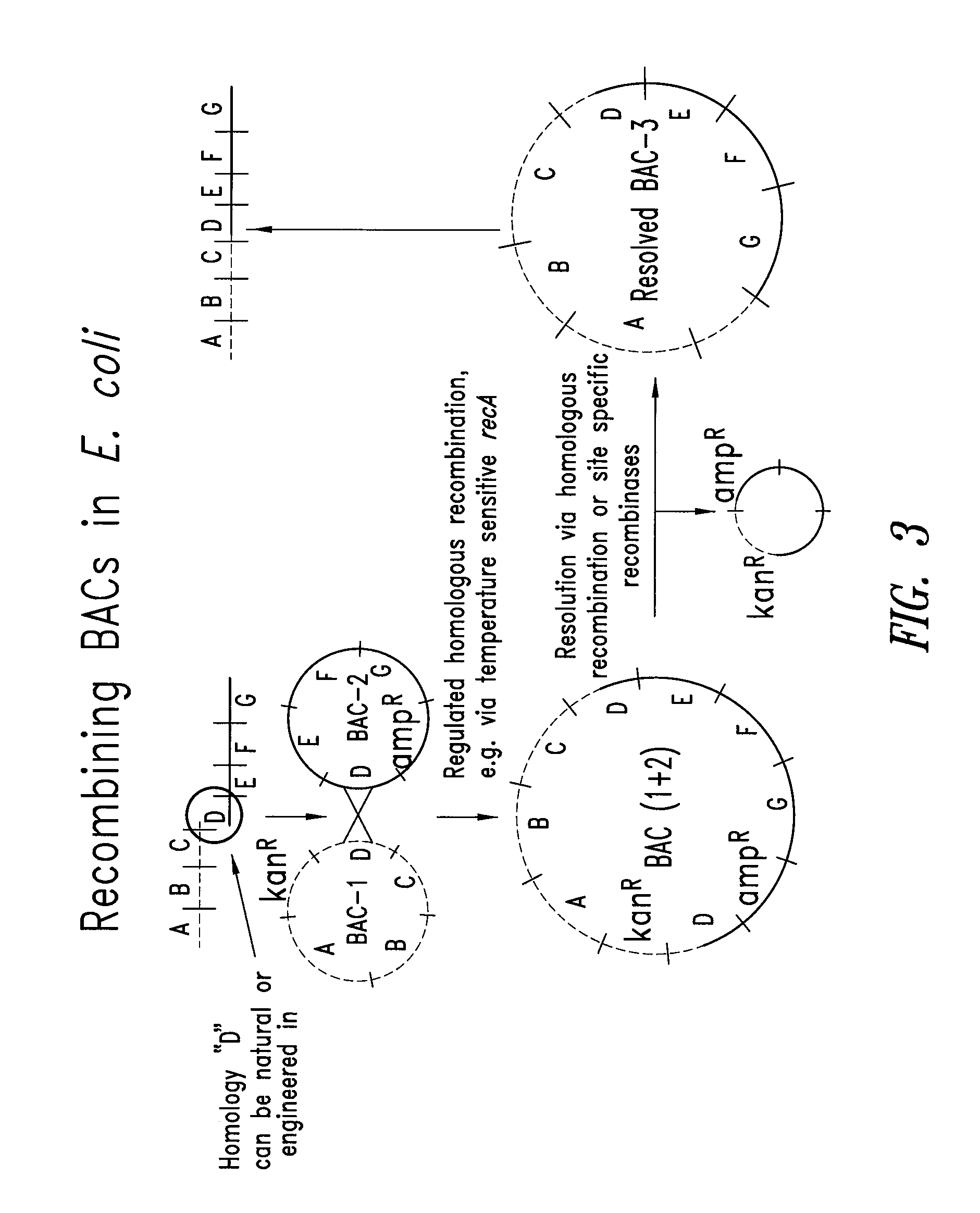Method of generating single vl domain antibodies in transgenic animals
a single-variable domain, antibody technology, applied in the direction of immunoglobulins, peptides, animals/humans, etc., can solve the problems of insufficiently meeting the complex requirements and regulation of various transgene constructs and methods tried in mice, suffering loss of binding to target antigens, and inefficient production of heavy-chain only antibodies
- Summary
- Abstract
- Description
- Claims
- Application Information
AI Technical Summary
Benefits of technology
Problems solved by technology
Method used
Image
Examples
example 1
Incorporation of Large BACs into Embryonic Stem Cells
[0102]Homologous recombination in E. coli to construct larger BACs is described in U.S. Patent Application Publication No. 2004 / 0128703. Such methods can be used to make BACs with larger inserts of DNA than is represented by the average size of inserts currently available BAC libraries. Such larger inserts can comprise DNA representing human Ig genes such Vκ and Vλ. The DNA inserts can also comprise DNA representing the endogenous Ig loci including some or all of the constant region genes, which can be subsequently modified.
[0103]A BAC to be introduced into ES cells may be comprised of human Ig DNA flanked on either side by 1 kb to 10 kb to 100 kb or more of mouse DNA from the corresponding endogenous mouse genome in the ES cell. The BAC then replaces a portion of the endogenous mouse genome by homologous recombination into the target DNA on the target chromosome in ES cells, replacing the endogenous mouse DNA between the two flan...
example 2
Homologous Recombination of BACs in E. coli
[0106]A BAC vector is based on the F-factor found in E. coli. The F-factor and the BAC vector derived from it are maintained as low copy plasmids, generally found as one or two copies per cell depending upon its life cycle. Both F-factor and BAC vector show the fi+ phenotype that excludes an additional copy of the plasmid in the cell. By this mechanism, when E. coli already carries and maintains one BAC, and then an additional BAC is introduced into the E. coli, the cell maintains only one BAC, either the BAC previously existing in the cell or the external BAC newly introduced. This feature is extremely useful for selectively isolating BACs homologously recombined as described below.
[0107]The homologous recombination in E. coli requires the functional RecA gene product. In this example, the RecA gene has a temperature-sensitive mutation so that the RecA protein is only functional when the incubation temperature is below 37° C. When the inc...
example 3
Design of BACs in E. coli
[0111]As described in U.S. Patent Application Publication No. 2004 / 0128703, the manipulation of BACs in E. coli provides a powerful tool for fine tailoring of the genomic DNA carried in the BACs. For example, to replace all or part of the mouse VH segment genes with human VL in the endogenous mouse IgH locus, a modified mouse BAC is made in E. coli and then used for homologous recombination in ES cells. For example, in the targeting BAC, the desired human VL gene segments, e.g., Vκ or Vλ are flanked on the 5′ side by mouse DNA 5′ of the most 5′ mouse VH gene and on the 3′ side of human VL gene-containing DNA by mouse DNA from either in or 3′ to the mouse VH gene cluster (see FIG. 2).
[0112]This replacement is similarly performed in E. coli using a sequential homologous recombination method with overlapping BACs for the human VL gene cluster to build a contiguous linked cluster. The VL gene cluster could also be recombined with human D, and / or J regions and e...
PUM
| Property | Measurement | Unit |
|---|---|---|
| concentrations | aaaaa | aaaaa |
| concentrations | aaaaa | aaaaa |
| time | aaaaa | aaaaa |
Abstract
Description
Claims
Application Information
 Login to View More
Login to View More - R&D
- Intellectual Property
- Life Sciences
- Materials
- Tech Scout
- Unparalleled Data Quality
- Higher Quality Content
- 60% Fewer Hallucinations
Browse by: Latest US Patents, China's latest patents, Technical Efficacy Thesaurus, Application Domain, Technology Topic, Popular Technical Reports.
© 2025 PatSnap. All rights reserved.Legal|Privacy policy|Modern Slavery Act Transparency Statement|Sitemap|About US| Contact US: help@patsnap.com



